That link is a good web page to peruse for historical and current
information about this small city of about 30,000 people located in
southern California.
Here is its location in relation to Los Angeles, San Bernardino, and
San Diego, CA and Yuma, AZ, all marked with yellow dots. I marked 29
Palms, the handy abbreviation often used for the city, with a purple dot:

Although 29 Palms was incorporated only relatively recently -- 1987
-- it has been a magnet for Native Americans for much longer, thanks
to the life-giving springs now called the Oasis of Mara.
The area was
discovered by gold prospectors in the 1870s, and developed as a
homesteading community with free land for people willing to settle here in
the 1920s. The city was named for the twenty-nine (plus or minus) palms that
grew near the springs.
Here is the left half of one of the large murals
in town that pays homage to the early nomadic Native Americans and miners who once
lived here:

Now the city serves as a convenient gateway to nearby Joshua Tree National
Park (dark green area just south of town on the map above) and the southern Mojave Desert.
It also provides services and housing
for the thousands of military personnel, their family members, and
contractors who work at the large Marine base five miles north of town.
Many descendents of the first homesteaders still call 29 Palms
home, as well as newcomers of all ages and occupations --
including artistic folks and retirees looking for a small city in a warm, dry location with
lots of things to do and see.
On the city's
web page, scroll down to the twenty-nine reasons to visit 29 Palms
for some fun and interesting reading!
MURALS & MORE
After I was done hiking up at Joshua Tree National Park one day this past
week, I spent a couple hours in the afternoon driving and walking around 29 Palms in an
effort to find as many of the twenty-three painted murals as I could
that decorate the walls of buildings in town.
There is probably a map of them available on the internet or from the
Chamber of Commerce but I didn't hunt for one. I figured I could find
most of them by just driving through town, and I did.
I photographed eighteen of the murals, including this long painting near the
visitor center that depicts some of the local Mojave Desert flora and
fauna in soft pastel colors:
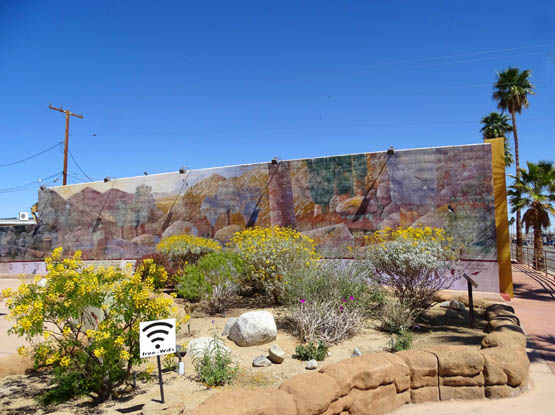

The murals are a fun and easy way to learn about the history of the area.
Many of them pay tribute to people who made significant contributions
to the development of the community, including military personnel.
I've included photos in this entry from about half of the murals I found.
I've mentioned the gold prospectors who flocked to this area in the
late 1800s in entries about
Joshua Tree National Park. This mural called "The Dirty Sock Camp"
depicts these miners:
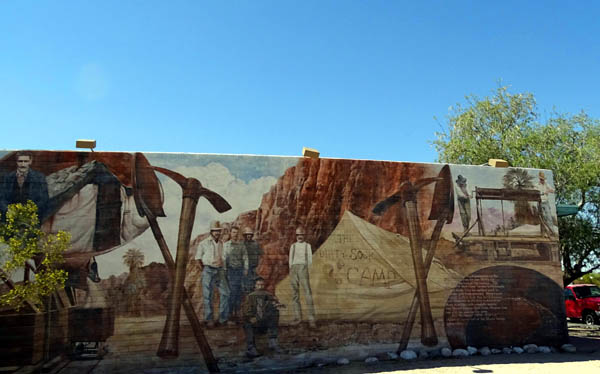
The verbiage in the lower right of that photo explains
the "dirty sock" concept: The best method of separating gold from
mercury was using chamois leather but if the miners didn't have any on
hand, they simply used old socks for the task.
The next mural honors one of the miners, Bill Keys and his wife
Frances, who raised five children up on the remote desert plateau in
what is now the national park:

That's just part of the mural. An explanation to the
right of Keys' picture describes how he arrived in 1910 as caretaker of
the once-prosperous Desert Queen Mine. After the mine closed, he claimed
it and the mill site, which became his ranch house, for his unpaid wages.
Bill and his wife worked hard to raise their family in that
location; he lived there until his death in 1969.
The next three pictures from Historic Plaza also include metal statues of
the honorees, Bill and Ada Hatch, early homesteaders who became
important leaders in this community:


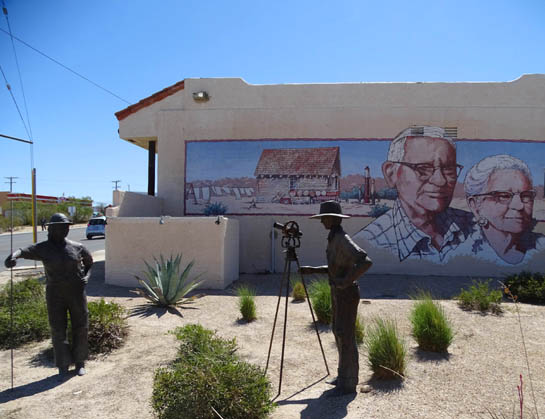
Then there's "Cactus Jack" Jones, who had another
nickname, too -- "The Flying Constable." He and his wife
were early homesteaders in the community. He served as the constable
from 1932 until his death in 1960:

Jones flew a Piper J-3 Cub out of his own airfield to
patrol over 2,800 square miles of rugged, remote desert territory. In
addition to serving warrants and tracking down bad guys, he also rescued
stranded travelers, transported sick and injured patients, and even
air-dropped supplies when needed.
Another local citizen who made a big impact on the
community was Dr. James Luckie, a Pasadena, CA physician who served as a
medical officer in WWI:

After the war, many veterans who Dr. Luckie treated were diagnosed with
tuberculosis and the effects of mustard gas. In an effort to help them
recover, the good doctor set out to
find a suitable dry, clean desert area where people suffering heart and
respiratory ailments could live and regain their health.
He chose 29 Palms and encouraged veterans to apply for the free 160-acre
homesteading sites made available by the federal government in the
1920s. Dr. Luckie often visited the area to tend to his patients --
for free! He also donated back to the town a gift of 40 acres of
land given to him by veteran Bill Campbell, another resident honored
with a large mural. That land is now Luckie
Park.
It's fitting that Dr. Luckie's mural is on one of
the medical buildings in town.
MILITARY MURALS & VETERAN'S PARK
I found at least two murals and a park in town that
are dedicated to the military.
The next photo is part of a large mural honoring the base's 7th
Expeditionary Brigade, which was the first force to arrive in Saudi
Arabia in 1990 for the build-up to Desert Storm:

When the busloads of troops came home, thousands of people living in the
Morongo Basin welcomed them at all hours of the day and night along the
boulevard leading to the base. In addition, 40,000 people attended the Desert
Storm Victory Parade, the largest crowd ever assembled in 29 Palms.
The next mural dedicated to those who fought in "Iraqi Freedom" in 2003
is so big I'm including all of it in two photos, plus an enlargement of
the verbiage and a quote from General James Mattis:
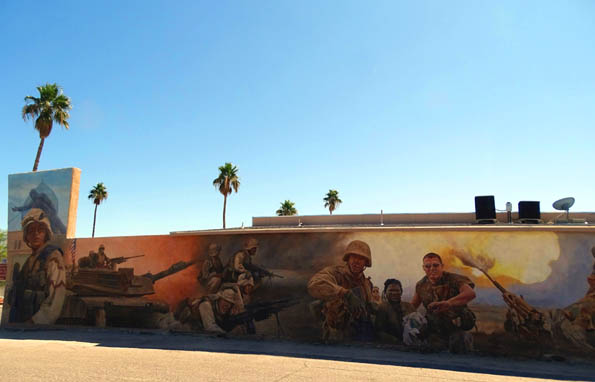

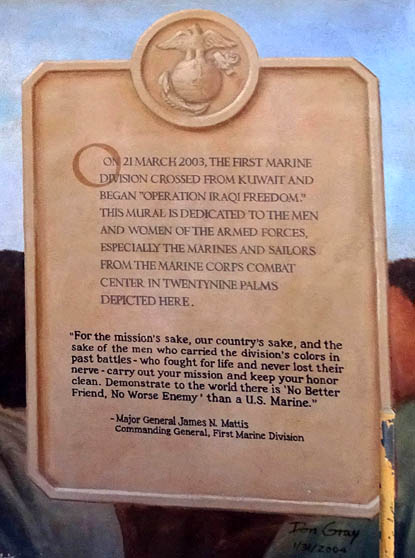
In some quarters these Middle East conflicts are as controversial as
Viet Nam. Regardless of your political views, I think the men and women
who have served, and continue to serve, our country to preserve freedom
around the world deserve as much support as we can give them.
Thank you to every former and current military person
who has ever served our country, including my husband, brother, brothers-in-law,
stepsons, and many of our friends and acquaintances!!


Marines serving at the local base have made a huge contribution to the
local community and the citizens of 29 Palms appreciate their service
and loyalty.
We could see and feel that respect everywhere we went during the week we
were here.
BUCKLIN PARK & OTHER SCENES IN TOWN
I also photographed the beautiful city park next to the visitor
center and the handsome boulevard that leads
visitors from town toward the north entrance of Joshua Tree National Park.
Jerry Bucklin Park is named in honor of retired U.S. Marine and San
Bernardino County Sheriff's Deputy Gerald Bucklin, who worked diligently
to prepare and maintain all of the town's mural sites until his death in 1997.
This is the location of the long mural showcasing some of the local
flora and fauna that I talked about earlier in this entry. It was full
of real blooming flowers, shrubs, and trees this week, a lovely place to
take pictures, eat lunch, meet friends, or just relax:




Above and below: two of the
flowering shrubs

I parked the car a couple of places along the
attractive boulevard in the next set of photos, including at the Old Schoolhouse Museum, so I
could walk around to take photos of the interesting metal sculptures,
palm trees, and cactus flowers in the median:







Above and below: Engelmann
hedgehog cactus


Teddy bear cholla

Beavertail prickly pear
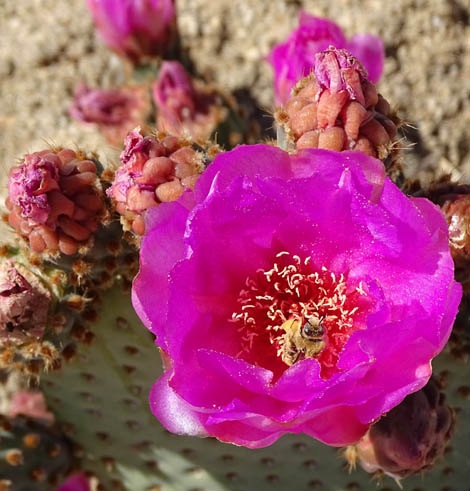
Above and below: close-ups of bee in
Beavertail cactus flower


The prettiest multi-colored prickly pear cactus
I've ever seen!
ARTISTIC LICENSE
We had also driven by an unusual art display about five miles east of town on
US 62 during our scouting trip to the area in January but it was raining,
getting dark, and we were in a hurry to get back to our RV park that night
at Yuma Proving Ground so we didn't stop to look at it then.
This week I drove out there to find it and take pictures. I read that
the bikes, sculptures, and teensy chapel are on the property of an
artist who lives here. I'm including just part of what's on display in
the yard:
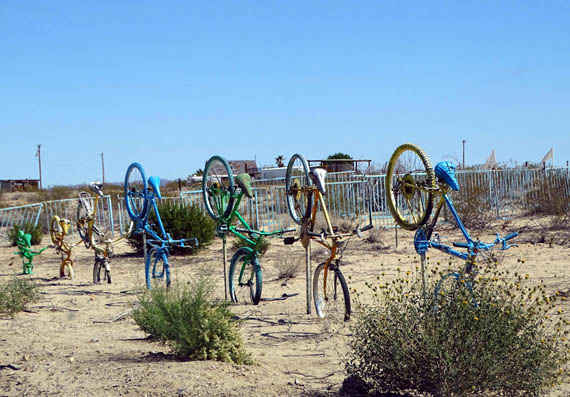

As the city's web page referenced at the beginning of this entry
enumerates, there are at least twenty-nine good reasons to visit 29
Palms. It appeals to people of all ages and interests, especially in the
cooler months of the year when temps aren't in the triple digits.
Next entry: the RV nomads head northwest to the China
Lake Naval Air Weapons Station near Ridgecrest, CA for a week
Happy trails,
Sue
"Runtrails & Company" - Sue Norwood, Jim O'Neil,
Cody the ultra Lab, and Casey-pup
Previous
Next
© 2016 Sue Norwood and Jim O'Neil





































